Renjie Liao
ControlEchoSynth: Boosting Ejection Fraction Estimation Models via Controlled Video Diffusion
Aug 25, 2025



Abstract:Synthetic data generation represents a significant advancement in boosting the performance of machine learning (ML) models, particularly in fields where data acquisition is challenging, such as echocardiography. The acquisition and labeling of echocardiograms (echo) for heart assessment, crucial in point-of-care ultrasound (POCUS) settings, often encounter limitations due to the restricted number of echo views available, typically captured by operators with varying levels of experience. This study proposes a novel approach for enhancing clinical diagnosis accuracy by synthetically generating echo views. These views are conditioned on existing, real views of the heart, focusing specifically on the estimation of ejection fraction (EF), a critical parameter traditionally measured from biplane apical views. By integrating a conditional generative model, we demonstrate an improvement in EF estimation accuracy, providing a comparative analysis with traditional methods. Preliminary results indicate that our synthetic echoes, when used to augment existing datasets, not only enhance EF estimation but also show potential in advancing the development of more robust, accurate, and clinically relevant ML models. This approach is anticipated to catalyze further research in synthetic data applications, paving the way for innovative solutions in medical imaging diagnostics.
Score Augmentation for Diffusion Models
Aug 11, 2025Abstract:Diffusion models have achieved remarkable success in generative modeling. However, this study confirms the existence of overfitting in diffusion model training, particularly in data-limited regimes. To address this challenge, we propose Score Augmentation (ScoreAug), a novel data augmentation framework specifically designed for diffusion models. Unlike conventional augmentation approaches that operate on clean data, ScoreAug applies transformations to noisy data, aligning with the inherent denoising mechanism of diffusion. Crucially, ScoreAug further requires the denoiser to predict the augmentation of the original target. This design establishes an equivariant learning objective, enabling the denoiser to learn scores across varied denoising spaces, thereby realizing what we term score augmentation. We also theoretically analyze the relationship between scores in different spaces under general transformations. In experiments, we extensively validate ScoreAug on multiple benchmarks including CIFAR-10, FFHQ, AFHQv2, and ImageNet, with results demonstrating significant performance improvements over baselines. Notably, ScoreAug effectively mitigates overfitting across diverse scenarios, such as varying data scales and model capacities, while exhibiting stable convergence properties. Another advantage of ScoreAug over standard data augmentation lies in its ability to circumvent data leakage issues under certain conditions. Furthermore, we show that ScoreAug can be synergistically combined with traditional data augmentation techniques to achieve additional performance gains.
StreamSplat: Towards Online Dynamic 3D Reconstruction from Uncalibrated Video Streams
Jun 10, 2025Abstract:Real-time reconstruction of dynamic 3D scenes from uncalibrated video streams is crucial for numerous real-world applications. However, existing methods struggle to jointly address three key challenges: 1) processing uncalibrated inputs in real time, 2) accurately modeling dynamic scene evolution, and 3) maintaining long-term stability and computational efficiency. To this end, we introduce StreamSplat, the first fully feed-forward framework that transforms uncalibrated video streams of arbitrary length into dynamic 3D Gaussian Splatting (3DGS) representations in an online manner, capable of recovering scene dynamics from temporally local observations. We propose two key technical innovations: a probabilistic sampling mechanism in the static encoder for 3DGS position prediction, and a bidirectional deformation field in the dynamic decoder that enables robust and efficient dynamic modeling. Extensive experiments on static and dynamic benchmarks demonstrate that StreamSplat consistently outperforms prior works in both reconstruction quality and dynamic scene modeling, while uniquely supporting online reconstruction of arbitrarily long video streams. Code and models are available at https://github.com/nickwzk/StreamSplat.
TrajFlow: Multi-modal Motion Prediction via Flow Matching
Jun 10, 2025Abstract:Efficient and accurate motion prediction is crucial for ensuring safety and informed decision-making in autonomous driving, particularly under dynamic real-world conditions that necessitate multi-modal forecasts. We introduce TrajFlow, a novel flow matching-based motion prediction framework that addresses the scalability and efficiency challenges of existing generative trajectory prediction methods. Unlike conventional generative approaches that employ i.i.d. sampling and require multiple inference passes to capture diverse outcomes, TrajFlow predicts multiple plausible future trajectories in a single pass, significantly reducing computational overhead while maintaining coherence across predictions. Moreover, we propose a ranking loss based on the Plackett-Luce distribution to improve uncertainty estimation of predicted trajectories. Additionally, we design a self-conditioning training technique that reuses the model's own predictions to construct noisy inputs during a second forward pass, thereby improving generalization and accelerating inference. Extensive experiments on the large-scale Waymo Open Motion Dataset (WOMD) demonstrate that TrajFlow achieves state-of-the-art performance across various key metrics, underscoring its effectiveness for safety-critical autonomous driving applications. The code and other details are available on the project website https://traj-flow.github.io/.
Neural MJD: Neural Non-Stationary Merton Jump Diffusion for Time Series Prediction
Jun 05, 2025Abstract:While deep learning methods have achieved strong performance in time series prediction, their black-box nature and inability to explicitly model underlying stochastic processes often limit their generalization to non-stationary data, especially in the presence of abrupt changes. In this work, we introduce Neural MJD, a neural network based non-stationary Merton jump diffusion (MJD) model. Our model explicitly formulates forecasting as a stochastic differential equation (SDE) simulation problem, combining a time-inhomogeneous It\^o diffusion to capture non-stationary stochastic dynamics with a time-inhomogeneous compound Poisson process to model abrupt jumps. To enable tractable learning, we introduce a likelihood truncation mechanism that caps the number of jumps within small time intervals and provide a theoretical error bound for this approximation. Additionally, we propose an Euler-Maruyama with restart solver, which achieves a provably lower error bound in estimating expected states and reduced variance compared to the standard solver. Experiments on both synthetic and real-world datasets demonstrate that Neural MJD consistently outperforms state-of-the-art deep learning and statistical learning methods.
RETRO SYNFLOW: Discrete Flow Matching for Accurate and Diverse Single-Step Retrosynthesis
Jun 04, 2025Abstract:A fundamental problem in organic chemistry is identifying and predicting the series of reactions that synthesize a desired target product molecule. Due to the combinatorial nature of the chemical search space, single-step reactant prediction -- i.e. single-step retrosynthesis -- remains challenging even for existing state-of-the-art template-free generative approaches to produce an accurate yet diverse set of feasible reactions. In this paper, we model single-step retrosynthesis planning and introduce RETRO SYNFLOW (RSF) a discrete flow-matching framework that builds a Markov bridge between the prescribed target product molecule and the reactant molecule. In contrast to past approaches, RSF employs a reaction center identification step to produce intermediate structures known as synthons as a more informative source distribution for the discrete flow. To further enhance diversity and feasibility of generated samples, we employ Feynman-Kac steering with Sequential Monte Carlo based resampling to steer promising generations at inference using a new reward oracle that relies on a forward-synthesis model. Empirically, we demonstrate \nameshort achieves $60.0 \%$ top-1 accuracy, which outperforms the previous SOTA by $20 \%$. We also substantiate the benefits of steering at inference and demonstrate that FK-steering improves top-$5$ round-trip accuracy by $19 \%$ over prior template-free SOTA methods, all while preserving competitive top-$k$ accuracy results.
UniEdit-Flow: Unleashing Inversion and Editing in the Era of Flow Models
Apr 17, 2025

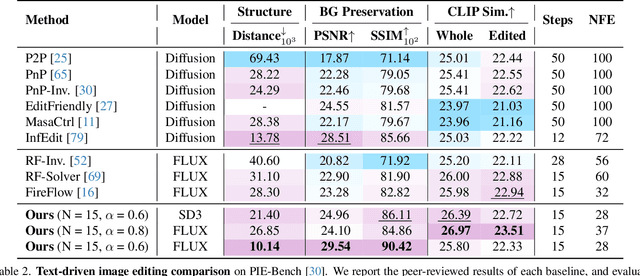
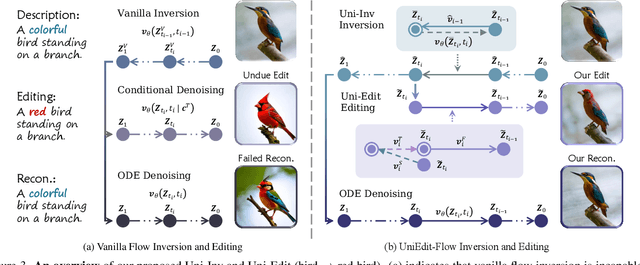
Abstract:Flow matching models have emerged as a strong alternative to diffusion models, but existing inversion and editing methods designed for diffusion are often ineffective or inapplicable to them. The straight-line, non-crossing trajectories of flow models pose challenges for diffusion-based approaches but also open avenues for novel solutions. In this paper, we introduce a predictor-corrector-based framework for inversion and editing in flow models. First, we propose Uni-Inv, an effective inversion method designed for accurate reconstruction. Building on this, we extend the concept of delayed injection to flow models and introduce Uni-Edit, a region-aware, robust image editing approach. Our methodology is tuning-free, model-agnostic, efficient, and effective, enabling diverse edits while ensuring strong preservation of edit-irrelevant regions. Extensive experiments across various generative models demonstrate the superiority and generalizability of Uni-Inv and Uni-Edit, even under low-cost settings. Project page: https://uniedit-flow.github.io/
Leveraging MoE-based Large Language Model for Zero-Shot Multi-Task Semantic Communication
Mar 21, 2025Abstract:Multi-task semantic communication (SC) can reduce the computational resources in wireless systems since retraining is not required when switching between tasks. However, existing approaches typically rely on task-specific embeddings to identify the intended task, necessitating retraining the entire model when given a new task. Consequently, this drives the need for a multi-task SC system that can handle new tasks without additional training, known as zero-shot learning. Inspired by the superior zero-shot capabilities of large language models (LLMs), we leverage pre-trained instruction-tuned LLMs, referred to as fine-tuned language net (FLAN), to improve the generalization capability. We incorporate a mixture-of-experts (MoE) architecture in the FLAN model and propose MoE-FLAN-SC architecture for multi-task SC systems. Our proposed MoE-FLAN-SC architecture can further improve the performance of FLAN-T5 model without increasing the computational cost. Moreover, we design a multi-task feature extraction module (FEM) which can adaptively extract relevant features across various tasks given the provided features and signal-to-noise ratio (SNR). Simulation results show that our proposed MoE-FLAN-SC architecture outperforms three state-of-the-art models in terms of the average accuracy on four different unseen tasks.
QDM: Quadtree-Based Region-Adaptive Sparse Diffusion Models for Efficient Image Super-Resolution
Mar 15, 2025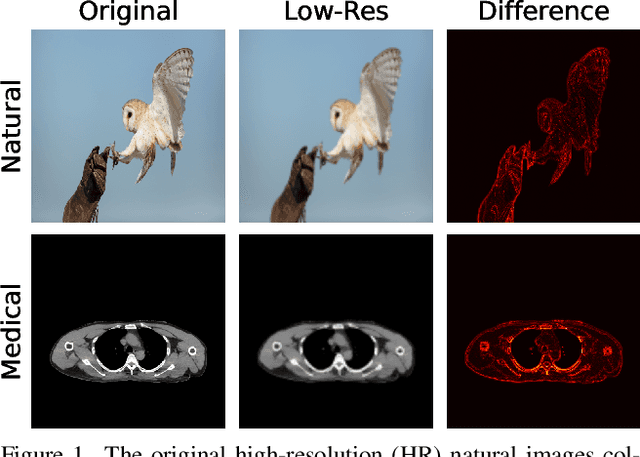
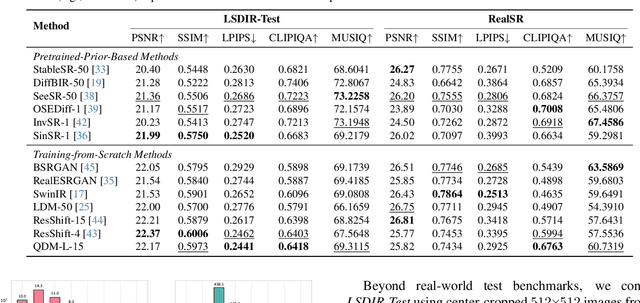

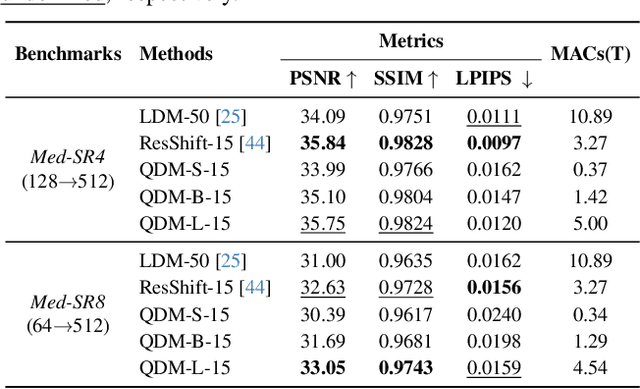
Abstract:Deep learning-based super-resolution (SR) methods often perform pixel-wise computations uniformly across entire images, even in homogeneous regions where high-resolution refinement is redundant. We propose the Quadtree Diffusion Model (QDM), a region-adaptive diffusion framework that leverages a quadtree structure to selectively enhance detail-rich regions while reducing computations in homogeneous areas. By guiding the diffusion with a quadtree derived from the low-quality input, QDM identifies key regions-represented by leaf nodes-where fine detail is essential and applies minimal refinement elsewhere. This mask-guided, two-stream architecture adaptively balances quality and efficiency, producing high-fidelity outputs with low computational redundancy. Experiments demonstrate QDM's effectiveness in high-resolution SR tasks across diverse image types, particularly in medical imaging (e.g., CT scans), where large homogeneous regions are prevalent. Furthermore, QDM outperforms or is comparable to state-of-the-art SR methods on standard benchmarks while significantly reducing computational costs, highlighting its efficiency and suitability for resource-limited environments. Our code is available at https://github.com/linYDTHU/QDM.
MoFlow: One-Step Flow Matching for Human Trajectory Forecasting via Implicit Maximum Likelihood Estimation based Distillation
Mar 13, 2025Abstract:In this paper, we address the problem of human trajectory forecasting, which aims to predict the inherently multi-modal future movements of humans based on their past trajectories and other contextual cues. We propose a novel motion prediction conditional flow matching model, termed MoFlow, to predict K-shot future trajectories for all agents in a given scene. We design a novel flow matching loss function that not only ensures at least one of the $K$ sets of future trajectories is accurate but also encourages all $K$ sets of future trajectories to be diverse and plausible. Furthermore, by leveraging the implicit maximum likelihood estimation (IMLE), we propose a novel distillation method for flow models that only requires samples from the teacher model. Extensive experiments on the real-world datasets, including SportVU NBA games, ETH-UCY, and SDD, demonstrate that both our teacher flow model and the IMLE-distilled student model achieve state-of-the-art performance. These models can generate diverse trajectories that are physically and socially plausible. Moreover, our one-step student model is $\textbf{100}$ times faster than the teacher flow model during sampling. The code, model, and data are available at our project page: https://moflow-imle.github.io
 Add to Chrome
Add to Chrome Add to Firefox
Add to Firefox Add to Edge
Add to Edge